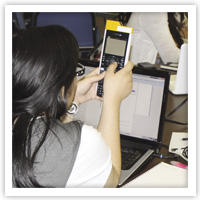 In the last dozen years, research on formative assessment has provided evidence of its promise as a strategy for teachers to know more about their students as they plan and teach lessons. However, the words formative assessment do not always mean the same thing to everyone. Researchers at CRDG emphasize formative assessment as what a teacher does to try to better understand what students know
In the last dozen years, research on formative assessment has provided evidence of its promise as a strategy for teachers to know more about their students as they plan and teach lessons. However, the words formative assessment do not always mean the same thing to everyone. Researchers at CRDG emphasize formative assessment as what a teacher does to try to better understand what students know
and to reveal what misunderstandings they may have. Formative assessment is a process that is fundamental to what teachers do and should be a natural practice in teaching and learning rather than a particular kind of measurement. The goal is that teachers learn to use information gleaned from the process of formative assessment in the classroom to plan instructional activities that further students’ understanding. CRDG researchers have actively investigated formative assessment in curriculum development, professional development, and program evaluation.
In the National Science Foundation-funded Formative Assessment in a Networked Classroom (FANC) project (see page 20), teachers are taught to watch for moments that have potential for formative assessment, moments that may arise out of students’ questions or ideas that come up in the discussion. “Connected classrooms, such as those that use the TI Navigator system, are where the real potential for formative assessment is realized,” said Judy Olson, FANC researcher. In a classroom equipped with the TI-Navigator system, what students know and can do can be easily assessed. Students can enter and send their responses to the teacher’s computer through their calculators. Similarly, teachers can easily send questions, and receive, organize, and display students’ answers, so that the interaction between the teacher and students as well as among students is greatly facilitated.
 The FANC project’s research has shown that the TI-Navigator system enables teachers to use formative assessment results more effectively because teachers are able to assess student learning in real-time. In addition to identifying and assessing what students’ know, the TI-Navigator system allows teachers to check on the level of student engagement, clarify the source of student misconceptions at an early stage, create responses to students immediately, and use a variety of feedback methods. While feedback in the regular classroom is typically very slow, classroom networked technology provides rapid feedback to improve learning in real time. Teachers are able to see what students understand during the process of instruction and to give in-depth and personalized feedback while adapting their teaching. They are aware of what every student is doing, rather than only those that speak up.
The FANC project’s research has shown that the TI-Navigator system enables teachers to use formative assessment results more effectively because teachers are able to assess student learning in real-time. In addition to identifying and assessing what students’ know, the TI-Navigator system allows teachers to check on the level of student engagement, clarify the source of student misconceptions at an early stage, create responses to students immediately, and use a variety of feedback methods. While feedback in the regular classroom is typically very slow, classroom networked technology provides rapid feedback to improve learning in real time. Teachers are able to see what students understand during the process of instruction and to give in-depth and personalized feedback while adapting their teaching. They are aware of what every student is doing, rather than only those that speak up.
In the CRDG science programs, formative assessment has been integrated in a more formal way. All of CRDG’s science programs have assessments that occur both during the course of laboratory and field investigations and through content-specific assessments. The programs’ instructional model is based on the practices of science. The cycle begins with an activity that presents an anomaly to engage students’ curiosity and motivate inquiry. Students analyze the anomaly, develop an explanatory hypothesis, and test it. Successful hypotheses are validated in the class community, and their universality is tested. Often, this starts a new cycle of anomaly identification. Within this framework, assessment is both formal and informal, and is broader than mere measurement. The format, which includes written work, homework, quizzes, and tests, also includes teacher observations, students’ actions and interactions, analysis of classroom discussion, students’ self-assessment, and students’ products and inventions. As program developer Frank Pottenger put it, “Formative assessment is the only way that we can truly know what the student knows—it provides richness and depth of understanding of student knowledge.”
“Formative assessment has lots of definitions,” said FANC researcher Judy Olson. But the key is student work. Formative assessment can be embedded into a curriculum, as in CRDG’s science programs, or teachers can be taught to recognize formative assessment opportunities, as in the FANC project. Ultimately, it is about using the instructional process to respond to students’ needs and provide effective and meaningful learning experiences.